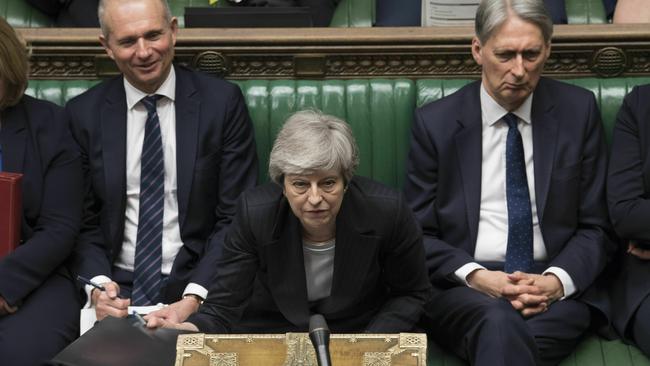Tory MPs mutiny as defiant May enters ‘death spiral’
A furious Conservative party is poised to change the rules to oust Theresa May if she doesn’t offer her resignation later today.

A furious Conservative party is poised to change the rules to oust Prime Minister Theresa May if she doesn’t offer her resignation later today.
Mrs May’s defiance of the souring mood of her cabinet and backbenchers — refusing to speak to senior ministers who wanted to tell her to resign on Wednesday night — appears not to have changed the toxicity surrounding her.
The mutiny by Tory MPs not to attend Prime Minister’s question time on Wednesday wasn’t just a token sign of resentment, it was a screech that the tone-deaf Mrs May has tried to ignore.
Even some of her most loyal backbenchers have called for her to stand down to retain a shred a dignity.
Iain Duncan Smith, the former Tory leader who was upended in a leadership coup himself, introduced the imagery of a defiant Mrs May propping up the sofa against the door of No 10 to retain power.
Foreign Secretary Jeremy Hunt, Home Secretary Sajid Javid and Scottish Secretary David Mundell all wanted an audience at Downing Street to tell her she had lost the confidence of the entire Tory party.
“I am not resigning,’’ was Mrs May’s blunt response — conveyed by Chief Whip Julian Smith to a meeting of 1922 backbench committee.
INSIDE STORY: How May sealed her own fate
Mrs May is unlikely to go quietly when she meets 1922 chief Sir Graham Brady later today, and in her typical style, will try to delay any firm commitment: deluded to the end about the Brexit bill, her own leadership and her place in history.
There was talk among the backbenchers of installing a caretaker leader once they have changed the party’s rules to force her out, and the chatter included references that Mrs May was in a “death spiral”.
The Prime Minister had all day yesterday to write her farewell: there was a blackout on political reporting because of British voting in EU elections.
While the EU result won’t be known until Monday (AEST) after other European countries have voted, it was expected to be a disaster for the Tories and for Labour as voters swung behind Nigel Farage’s Brexit Party.
Pollsters predicted the Tories would suffer their worst political result, attracting just 7 per cent support.
For months, Mrs May has clung to power by her fingertips amid open rebellion, a split cabinet and brazen campaigning by leadership hopefuls, but her downfall was secured when she announced parliament could vote for a second Brexit referendum if it supported her thrice-defeated Brexit bill.
Cabinet members objected, insisting they hadn’t agreed to the referendum offer.
The leader of the House of Commons, Andrea Leadsom, resigned from her position, saying she couldn’t put forward the Brexit bill as she was so fundamentally opposed to its new elements.
By doing so, Mrs Leadsom — the initial contender against Mrs May for the leadership in 2016 before scuppering her chances by commenting how Mrs May didn’t have children — has politically distanced herself from the Brexit disaster and can launch her own leadership campaign.
She would be up against the frontrunner former foreign secretary Boris Johnson, Mr Javid, Mr Hunt, and one of the ill-fated Brexit secretaries Dominic Raab.
Mrs May took the chance that offering the referendum in what she claimed was a bold new plan, and acquiescing to Labour’s demands for a Customs arrangement, would attract enough crossbench support for her bill to pass, even if it split the Tory party.
She badly miscalculated.
All the major parties have rejected the Brexit plan and if it is presented, the bill faces a humiliating loss by more than 100 votes.
If Mr Brady cannot convince Mrs May to resign, the 1922 committee has the numbers to change party rules.
The Prime Minister is currently immune from a leadership challenge until December because of a 12-month exception offered to her from surviving the previous vote of no confidence.
Contenders to replace Mrs May will be whittled down to two by a vote of Tory MPs, after which there will be a postal ballot of the Tory membership.
This can take about four to six weeks before a new leader is in place.


